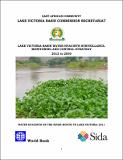| dc.contributor.author | Lake Victoria Basin Commission | |
| dc.date.accessioned | 2015-11-09T15:34:28Z | |
| dc.date.available | 2015-11-09T15:34:28Z | |
| dc.date.issued | 2011 | |
| dc.identifier.citation | Water hyacinth on the River mouth to Lake Victoria 2011 | en_US |
| dc.identifier.uri | http://repository.eac.int/123456789/690 | |
| dc.description.abstract | Aquatic weeds adversely affect water quality, biodiversity, amenity and
recreational values of water bodies. Community, social, cultural and economic
values derived from such water bodies are therefore impaired. Invasive weeds
also have adverse impacts on the structure and functions of wetlands and
other riparian ecosystems. Water hyacinth (Eichhornia crassipes (Martius)
Solms-Laubach) and other invasive aquatic weeds once established are very
difficult to manage and eradication is often impossible. The costs of invasive
weeds infestation on the environment, social and economic systems though
recognised are difficult to calculate but estimated impacts may be in the range
of millions of dollars Lake Victoria the world’s second largest freshwater body was severely infested
by water hyacinths, to catastrophic levels in the late 1980’s. The lake’s riparian
governments of Kenya, Tanzania and Uganda with support from development
partners successfully responded to the menace by applying a variety of water
hyacinth control methods such as biological, mechanical and manual/physical
removals. Chemical control method remained at only trial level and was never
done on large scale. Control of evasive weeds is one of the components of an
integrated approach to the management of the LVB | en_US |
| dc.description.sponsorship | World Bank and SIDA | en_US |
| dc.language.iso | en | en_US |
| dc.publisher | Lake Victoria Basin Commission | en_US |
| dc.subject | Water hyacinth | en_US |
| dc.subject | Catchment Management | en_US |
| dc.title | Water hyacinth on the River mouth to Lake Victoria 2011 | en_US |
| dc.type | Report | en_US |

